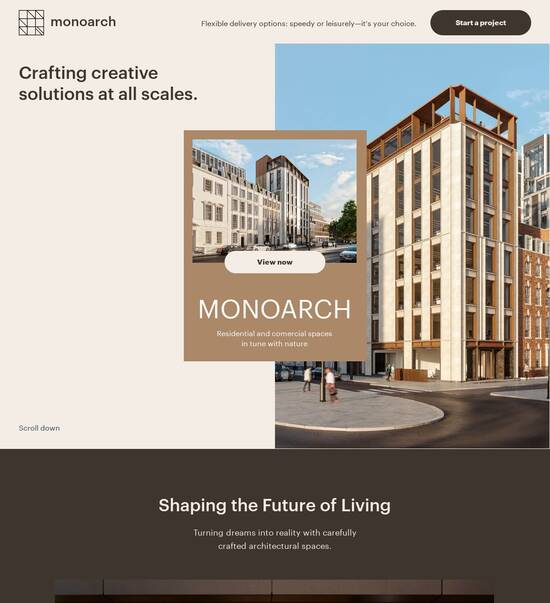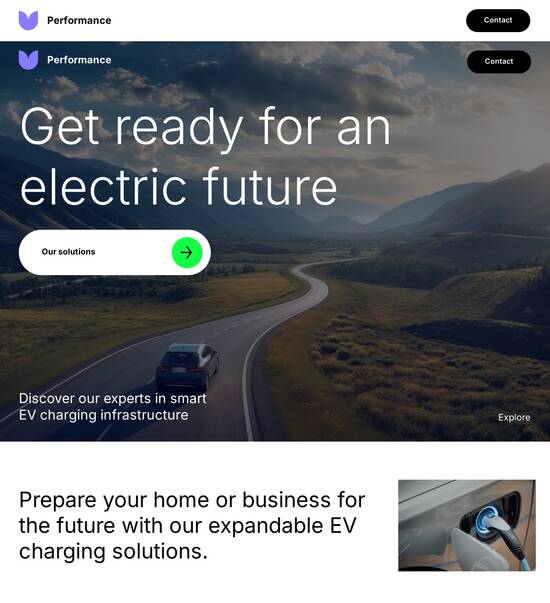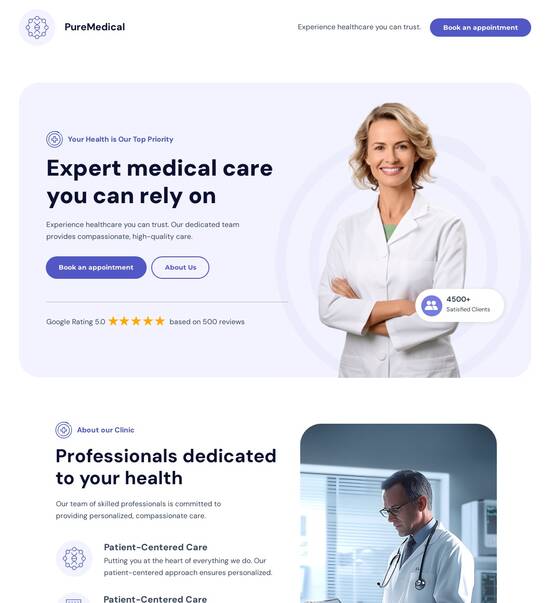
Onboarding page template for charter schools
Explore Similar TemplatesAbout template
Build your landing pages easily with onboarding page template for charter schools. Discover more tools for digital marketing and improve your conversions.
Recommended templates

Easy to build without coding
With the intuitive drag-and-drop builder, anyone on your team can create high-converting pages without any knowledge of code or design. Make enhancements to your landing page with custom widgets using Javascript, HTML/CSS, or third-party scripts.

Multiple layouts for any industry and goal
Select from 500+ landing page layouts built to boost conversions across industry-specific scenarios. Customize them by adjusting fonts, adding images, and generating on-brand content with the AI assistant. Quickly scale with Instablocks® and Global Blocks that you can save, reuse, and update globally.

Loads fast and looks polished on any device
Every template is responsive, which means they present professionally on any device and load blazingly fast with our Thor Render Engine. You can also power them up with Google AMP technology to deliver an unparalleled mobile experience and drive higher conversions.

Robust analytics & experimentation
Get real-time updates and reporting across all your devices, showing the number of visitors, conversions, cost-per-visitor, and cost-per-lead. Launch AI-powered experiments, run A/B tests, and use heatmaps to analyze user behavior, then optimize your landing page to maximize conversions.







Easy to build without coding
With the intuitive drag-and-drop builder, anyone on your team can create high-converting pages without any knowledge of code or design. Make enhancements to your landing page with custom widgets using Javascript, HTML/CSS, or third-party scripts.
Multiple layouts for any industry and goal
Select from 500+ landing page layouts built to boost conversions across industry-specific scenarios. Customize them by adjusting fonts, adding images, and generating on-brand content with the AI assistant. Quickly scale with Instablocks® and Global Blocks that you can save, reuse, and update globally.
Loads fast and looks polished on any device
Every template is responsive, which means they present professionally on any device and load blazingly fast with our Thor Render Engine.
Robust analytics & experimentation
Get real-time updates and reporting across all your devices, showing the number of visitors, conversions, cost-per-visitor, and cost-per-lead. Launch AI-powered experiments, run A/B tests, and use heatmaps to analyze user behavior, then optimize your landing page to maximize conversions.
All the features you need to build lead-generating landing pages
Explore more featuresLearn how to build top-performing landing pages for any goal
FAQs
Leading the way in building high-performing landing pages





Maximize your marketing impact with Instapage's powerful landing page and CRO tools
With Instapage, marketers in sectors such as business services, education, and financial services can create optimized landing pages that boost their campaign performance. Leveraging over 100 high-converting templates, marketers can effortlessly enhance their digital marketing strategies without needing extensive coding knowledge.
Understanding the power of landing pages
Landing pages play a pivotal role in any digital marketing campaign. They are designed to convert visitors into leads or customers, ensuring your marketing messages resonate effectively. Instapage simplifies this process with customizable layouts that allow anyone, regardless of skill level, to launch high-performance landing pages. The intuitive interface combined with built-in elements significantly reduces page-building time.
- Customization: Tailor pages to reflect your brand identity, ensuring consistency and recognition.
- Speed: Quickly build and launch landing pages, reducing time to market significantly.
- Integration: Seamlessly connect with your existing marketing tools to optimize the entire campaign workflow.
Step-by-step guide to create an effective landing page
Creating a successful landing page involves a strategic approach. Here's how you can use Instapage effectively:
- Select a template: Start with one of the 100+ pre-designed templates that align with your campaign goals.
- Customize elements: Use Instablocks and lead generation elements to modify the template to fit your needs without coding.
- Implement tracking: Use Instapage’s analytics tools to set up tracking for audience performance metrics.
Optimization strategies for better conversions
Once your landing page is live, optimizing it for conversions is crucial. Consider these effective strategies:
- A/B Testing: Conduct tests on different landing page elements such as headlines, images, and calls to action to see what performs best.
- Heatmaps: Leverage heatmap features to analyze visitor behavior and make data-driven adjustments.
- Personalization: Use dynamic content to personalize experiences based on user data, enhancing engagement and conversion rates.
In conclusion, leveraging Instapage allows you to create, optimize, and personalize landing pages that drive results for your marketing efforts. By following these steps, marketers can ensure their campaigns always achieve maximum ROI.
Start transforming your digital marketing efforts with Instapage today and see the difference optimized landing pages can make. Whether you're a small business or part of a larger corporation, Instapage has the tools to elevate your marketing strategy.
People also ask about Onboarding page template for charter schools
Onboarding page template for charter schools: A comprehensive guide
The essence of an onboarding page template for charter schools
In charter schools, the onboarding process is essential for creating a welcoming environment for new students and their families. An onboarding page serves as a crucial tool that helps streamline communication and ensures that everyone involved understands their roles and responsibilities. It facilitates smoother transitions by providing systematic guidance that caters specifically to the unique dynamics of charter schools. Given the diverse backgrounds of their students and the varying degrees of parental involvement, a well-crafted onboarding page template becomes an invaluable resource.
The goal of onboarding in charter schools is not just to convey information but to foster engagement. This requires differentiating charter school onboarding from general onboarding practices. Charter schools often face distinct challenges, such as limited resources, varied community involvement, and the necessity of establishing a sense of belonging in a new educational atmosphere. This complexity necessitates a tailored approach to onboarding, ensuring that everyone feels informed and included from the outset.
Key elements of an effective onboarding page template
An effective onboarding page must prioritize the delivery of concise and organized content. This allows users to grasp essential information quickly, eliminating confusion and uncertainty during a critical transition period. A clear navigation structure not only enhances user experience but also ensures that stakeholders can easily access the necessary information they need. It’s essential for information to be categorized logically, so users can digest it without overwhelming complexity.
Just as important as streamlined information is the welcoming visual design of the page. First impressions matter, and utilizing school branding—such as colors, logos, and images—can significantly affect how new families perceive the school. Incorporating elements that reflect the school’s identity instills pride and promotes a sense of belonging. Maintaining best practices when it comes to color schemes and themes can further enhance engagement, making the page not just informative but also visually appealing.
Interactive features can elevate the onboarding experience even further. Implementing forms that allow users to share feedback, ask questions, or express interests makes the page more engaging. Additionally, multimedia elements such as videos and graphics can help convey messages in a more approachable, fun manner, providing a sense of community right from the start.
The user journey: Step-by-step flow of the onboarding process
The onboarding process begins with a welcome section that sets a positive tone. This initial greeting is paramount; it should resonate with families and assure them that they have made a great choice in enrolling their children in the school. Tailoring messages for different stakeholders—students, parents, and faculty—creates an inclusive atmosphere where everyone feels valued. This section should be inviting and informative, encouraging engagement from the outset.
Following the welcome, informational segments serve to clarify essential policies and opportunities. A bullet-point format can effectively highlight key policies, such as attendance requirements and dress codes, without overwhelming readers. Furthermore, showcasing unique curriculum features and extra-curricular opportunities allows families to appreciate what differentiates the school from others, thereby enhancing their commitment to the institution.
An FAQ section is vital, as it can address common concerns proactively. This dynamic segment should evolve based on user interactions and feedback, ensuring that it remains relevant over time. Stepwise guidance on common issues—like enrollment procedures and transportation options—creates an additional layer of support that is essential for new families trying to navigate the onboarding process.
Leveraging technological features for optimization
To further optimize the onboarding experience, schools can implement filtering functionality. This allows users to customize the information they receive based on their roles, whether they are new students or returning families. Such personalization makes onboarding feel much more tailored, assisting users in finding the relevant information they need without sifting through irrelevant content.
A critical aspect of this technological optimization is ID management. Implementing a unique ID for each stakeholder helps to enhance security and track user journeys through the onboarding page. This can enhance communication and enable follow-ups tailored to individual needs, thereby improving engagement and responsiveness. By ensuring the right information reaches the right individuals, schools can maintain a high level of interaction.
Additionally, employing techniques like FlateDecode ensures efficient navigation through the content. Content decoding capabilities impact load times and perceived performance significantly, leading to a more satisfying user experience. When users find information easily and quickly, the onboarding process feels positive and engaging rather than burdensome and complicated.
Ensuring content relevancy and update mechanisms
Keeping content relevant is crucial for effective onboarding, and employing features like Prev and Xref can assist with this maintenance. By utilizing dynamic content presentation, schools can ensure information remains current, adapting quickly to changes in policies or procedures. Moreover, reviewing the experiences of previous onboarding cohorts allows the school to implement necessary updates based on stakeholder feedback.
Institutions should develop an ongoing content strategy that prioritizes updates and relevancy. This means regularly soliciting feedback from families who have recently gone through the onboarding process to understand their perspectives and challenges. By being responsive and adaptable, charter schools can continually improve their onboarding processes, ensuring each cohort’s experience is better than the last.
Engaging with stakeholders through content
Content should always aim to engage stakeholders in a relatable way. This can be achieved by incorporating community-centric narratives that emphasize shared values and experiences within the school environment. Highlighting success stories and testimonials from alumni and families creates an emotional connection, showcasing the tangible benefits of being part of the school community.
Furthermore, schools can create content that invites community involvement. Announcements about events, volunteer opportunities, or how families can contribute to the school culture provide a sense of ownership and connection. When stakeholders feel that their participation matters, it enhances loyalty and engagement, fostering a stronger school community.
Analyzing metrics for continuous improvement
Metrics play a pivotal role in understanding how well the onboarding page is performing. Schools should focus on indexing user interaction to gather data that helps improve the experience. Key metrics to track might include bounce rates, engagement levels, and section completion rates. Analyzing this data enables institutions to identify what works well and what requires enhancement to better serve their families.
Case studies of schools that have successfully adapted their onboarding templates based on data-driven insights illustrate the value of this approach. By creating a feedback loop where analytics inform improvements, schools can ensure that their onboarding page remains relevant and effective in meeting the dynamic needs of students and parents.
Bridging traditional and digital methodologies
Incorporating both offline and online strategies can greatly enhance the onboarding experience for families. Evidence of how schools bridge traditional and digital methodologies can often be seen through coordinated efforts between virtual onboarding phases and in-person orientations. This hybrid approach allows institutions to cater to diverse family needs while ensuring all stakeholders receive a thorough and consistent onboarding experience.
Transitioning smoothly between these modalities can enhance engagement by providing families multiple ways to connect with the school. For instance, virtual tours or live webinars can supplement in-person events, offering flexibility that meets the varying schedules and preferences of families. This comprehensive engagement strategy will ultimately create a more inclusive and informed community.
Future trends in onboarding for charter schools
As technology continues to evolve, so too will the onboarding processes utilized by charter schools. Predictions suggest that processes may increasingly incorporate advanced technologies such as artificial intelligence and virtual reality to create immersive onboarding experiences. AI, for example, could enable more refined personalization, tailoring the onboarding experience to individual needs and preferences, thus enhancing user satisfaction.
Furthermore, virtual reality could allow prospective students and families to experience the school environment in an interactive manner, providing a strong sense of connection before they ever step foot on campus. As these systems develop and become more accessible, charter schools that leverage these innovations will stand out, enhancing their ability to attract and retain families by offering compelling onboarding experiences.
Highlighting innovative examples of successful onboarding pages
Several charter schools have successfully implemented onboarding page templates that serve as excellent models for others. These schools showcase features that make their onboarding processes stand out, including intuitive design, clear navigation, and engaging interactive elements. Studying these examples allows other institutions to gather inspiration and identify best practices that contribute to an effective onboarding experience.
The effectiveness of these templates often lies in their ability to comprehensively cover all relevant information, while also engaging users through multimedia and community-building narratives. As schools continue to refine their onboarding processes, the sharing of successful case studies will be instrumental in fostering innovation and effective communication across charter schools.
Ready to skyrocket conversions?
Supercharge your ad campaigns with high-performing landing pages
Get started














